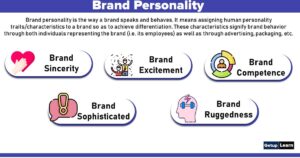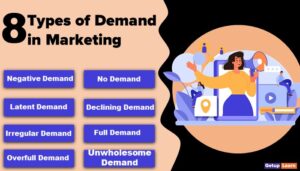Table of Contents
- 1 What is a Brand?
- 2 What is Branding?
- 3 What is a Brand Name?
- 4 What is Brand Mark?
- 5 What is Trademark?
- 6 What are Patents?
- 7 What is Copy Right?
- 8 Difference Between Brand and Trademark
- 9 Advantages of Brand Names
- 10 Choosing a Brand Name
- 11 Types of Brands
- 12 Branding Strategies
- 13 Advantages of Branding
- 14 Disadvantages of Branding
- 15 FAQ Related to Branding
What is a Brand?
The word “brand” is a comprehensive term “A brand is a name, term, symbol, or design or a combination of them that is intended to identify the goods or services of one seller or group of sellers and to differentiate them from those of competitors”.
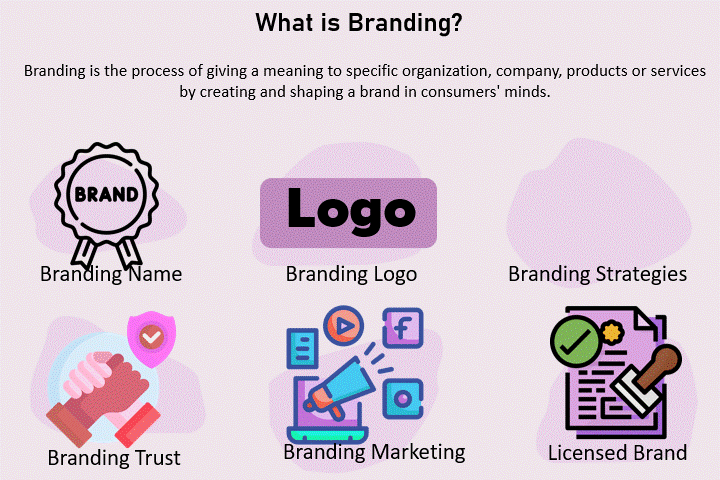
What is Branding?
Branding is the management process by which a product is branded. It is a general term covering various activities such as giving a brand name to a product, designing a brand mark, and establishing and popularizing it.
Branding is an important part of product management, which involves researching, developing, and implementing brand names, brands, marks, trade characters, and trademarks.
What is a Brand Name?
A brand name is a part of a brand consisting of a word, letters comprising a name that is intended to identify the goods or services of a seller or a group of sellers and to differentiate them from those of a competitor.
The brand name is a word or combination of words used to identify a product and differentiate it from other products. All brand names are trademarks, but not all trademarks are brand names. The brand name is that of the brand that can be vocalized.
A brand name may be, but need not be a trading name. For example, Coca-Cola is a trading name that is also the brand name of the company’s leading product.
What is Brand Mark?
A brand mark is the part of the brand which appears in the form of a symbol, design, or distinctive coloring or lettering. For example, Ganda Phenyl.
What is Trademark?
A trademark has been defined as any sign, mark, symbol, word, or word, which indicates the origin or ownership of a product as distinguished from its quality and which others do have no equal rights to employ for the same purpose.
A trademark is a brand name, brand mark, or trade character or combination thereof with legal protection. When registered a trademark is flowed by R.
Business firms need some techniques to differentiate their products from those manufactured by others. This is efficiently done by trade-marking them by using letters, words, groups of words, symbols, signs, or any combination of these.
What are Patents?
Patents are public documents offering certain rights, privileges, titles, or offices. A patent confers the right to the use of a technical invention. When a new invention is made, it is registered so that an exclusive right is obtained by the inventor to use it.
What is Copy Right?
This is an application in the case of books and is used in the same meaning as that of patents. It is the sole right to reproduce literary, dramatic, musical, or artistic work. Copyright is available for the whole of the author’s lifetime and sixty years after his death.
Difference Between Brand and Trademark
The process of branding includes the functions of giving brand name and trademark to any product. However, there are some differences between brand name and trademark. The difference between brand and trademark can be mentioned as follows:
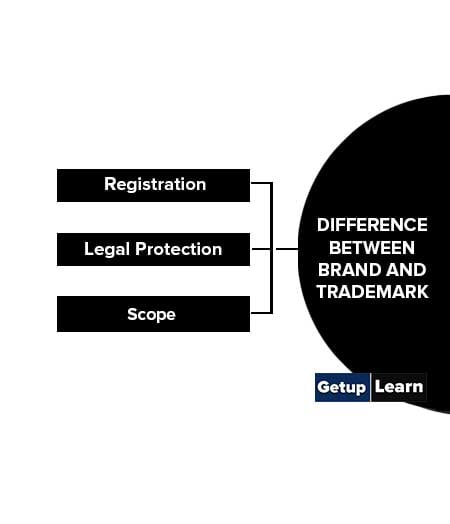
Registration
Any name, word, letter, symbol, design or any sign composed by combining them is called brand. If the same sign is legally registered in the concerned government office, it called trademark.
Legal Protection
Trademark is provided legal protection, No other company or firm can use this trademark except the producer or seller, which has got it registered. But brand or any symbol, sign can be used by other firms or competing companies. No legal action can be taken even if any company imitated a brand used by other company.
Scope
All trademark includes in brand but all brands may not be trademarks. So, all trademarks are brands, but all brands are not trademarks. In this way, there is basic difference between trademark and brand.
Both of them involve in branding, both of them give identity of products and differentiate from same type products of other companies. But legal protection can be acquired only from registered trademark.
Advantages of Brand Names
There are many advantages of brand names to the manufacturers, distributors and consumers:
-
Vehicle of Goodwill: It works as a vehicle of goodwill to the seller, by which the article presented for sale may be organized and made effective as a cumulative force in selling. It may prove a valuable asset to the seller.
-
Stability of Sales Volume and Price: The seller achieves greater stability of sales volume and greater stability of price through transforming his product, to the maximum possible degree in specialty goods.
-
Healthy Brand Create a Sound Image of the Company: If it wants to bring out new product line or categories they will be welcomed by the customers. This is because the first impression can be a lasting impression.
-
Brand Names Make the Product Easily Distinguishable and Identifiable: Markets are often very large with a massive range of similar products. There is usually a need to differentiate a product from that of the competitor. This is efficiently done by branding.
-
Symbol of Quality: Consumers look upon the brand names as a symbol of product quality of a product’s characteristics and feature and as a symbol of the satisfaction product supplies.
-
Insurance: Branding is an insurance of merchandise comparability when the buyer uses more than one source of supply. Philip’s light bulbs are Philips’s light bulbs, regardless of where purchased.
- When the brands contribute to the sound reputation of the companies, middlemen also get benefit out of it because their effort to act between the manufacturer and the end user are minimized.
- If a firm has one or more lines of branded goods, it can add a new item to its product mix much more easily than a company selling unbranded merchandise.
- A firm can advertise its product and associate each brand and its characteristics in the buyer’s mind. This aids the consumer in forming brand image, which are the perceptions a person has of particular brand.
- As social visibility becomes more meaningful, a product’s prestige is enhanced via a strong brand name.
- People feel less risky when buying a brand with which they are familiar and for which they have a favorable attitude. This is why brand loyalty occurs.
- Branding provides another king of satisfaction to the consumer. When they are satisfied with a particular band they do not regret paying for it. They feel it worthwhile and reasonable.
Choosing a Brand Name
There are four branding decision a firm must undertake. These involve corporate symbols, the branding philosophy, choosing a brand name and using trademarks. We will discuss here only the “choosing a brand name”.
Selecting the right brand name is one of the most vital yet a tricky and frustrating element in developing a new product. A good product with a lackluster name may not sell as well as a mediocre product with an intriguing name.
And once it is chosen and the product is out on the market. Changing or modifying the name is not only difficult but also rather harmful, getting it right the first time is essential.
In the quest for making the brand name play well in the market the firms ought to ask themselves a few question that are related with the impact of the brand name upon the customers. The questions are represented in the figure:
The first hurdle to be overcome is to decide what type of name is appropriate. These are:
- Names whose meanings bear no connection to the product (Aravalli Scooters, Arrow Shirts)
- Names that sound interesting but have no meaning (Kodak, Sony)
- Names that are borrowed from words in other language (Lux)
- Names that belong to company founders (Ford, Tata)
- Names that are company initials (HMV)
- Names that suggest a function or quality of the product (Cool Foam)
- Names that are taken from myths and legends (Atlas, Hercules).
In each of these categories, various innumerable possibilities maybe explored. Therefore, the main criterion should be to see whether or not the name selected will help to sell the product.
Types of Brands
Following are the types of brands explained:
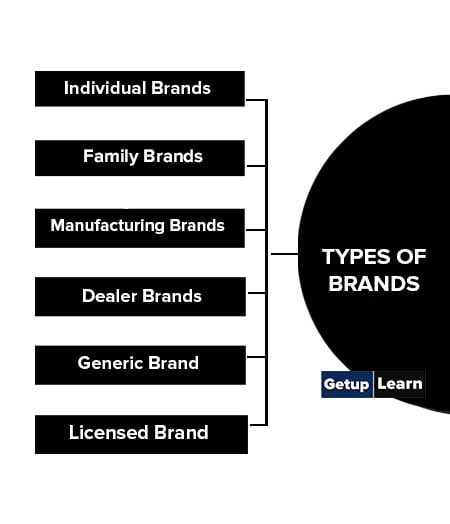
Individual Brands
A Company using individual brands uses separate brand names for each product, when its products vary in quality or type. If the products are really different such as Hindustan Lever Ltd. (HLL) – Individual brands are Pears, Lux, Lifebuoy, Rexona, Close-up and for Godrej- Individual brands are Cinthol, Ganga, Evita, glory, Marvel.
Sometimes firm use individual brands to encourage competition within the company. Each brand is managed by a different group within the firm. Management feels that internal competition keeps everyone alert .The theory is that if anyone is going to take business away, it ought to be one of the company’s own brands.
Family Brands
Branders of more than one product must decide whether they are going to use a family brand- the same brand name for several products-or individual brands for each product.
For examples, of family brands are like Godrej (cosmetics, refrigerators, and hair dye), Kissan (jam, ketchup, squashes, and pickle), Tata (oil, Salt, tea, machinery, watches, and steel), Maggie (sauce, noodles, pickle, and jam), Bata (shoes, sleepers, socks).
The use of the same brand for many products makes sense if all are similar in type and quality. The goodwill attached to one or two products may help the others, thus cutting promotion costs. It also tends to build loyalty to the family brand and makes it easier to introduce new products.
Manufacturing Brands
Manufacturing brands are brands created by manufacture. These are sometimes called “national brands”- because the brand is promoted all across the country or in large regions.
Such brands include Kellog’s, Whirlpool, Ford, and IBM, And creators of service-oriented firms-like McDonald’s. These brands spend a lot of money in promoting their brands in the same way that other products do.
Dealer Brands
Dealer brands are brands created by middlemen. These are sometime called “private brands” Manufacture and dealer brand names depend on whether the product is owned by producers or by intermediaries.
If the brand is owned by manufacturer that brand is classified as manufacture/national brand otherwise it is a dealer/private brand.
Generic Brand
Generic brand is also called as ‘No Brand’. Under the generic brand, product remains unbranded or without a brand name. Widespread consumer goods and pharmaceutical products, which are inexpensive and plainly packed, are under generic or no brand products. Most of the goods purchased by Indian household consumers are non-branded or generic products.
Generic products are most common for staples-especially food product and drug items. Typically, these are offered in plain packages at lower prices.
Licensed Brand
Here the brand names are licensed on ‘rent’ by the established manufacturers to the sellers of goods by tacking royalties or fee. These brands can have immediate effect on customers mind since the brand name used is well established in the market.
Branding Strategies
Following are the branding strategies adopted by the marketer:
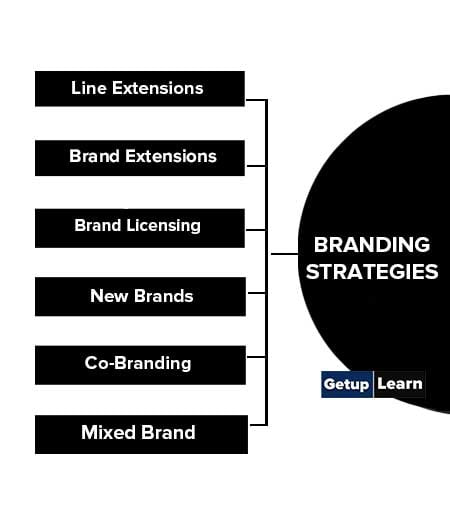
Line Extensions
Here the existing brand name is extended to new sizes or flavors in the existing product category. For instance a company can introduce additional products in the same line or product category using the existing brand name.
Brand Extensions
Branding strategy that uses an existing brand name to promote a new or improved product in a campany’s product line or product category. This strategy’s risk is overextending a product line and diluting the brand with too many products.
Brand Licensing
It involves a legal licensing agreement for which the licensing company receives a fee, such as royalty, in return for allowing another company to use its brand/brand/mark/trade character.
New Brands
New brand for a new category product.
Co Branding
Co–branding can be defined as a partnership between the marketing activities of at least two or more different brands which are also independent providers of products and services. This type of marketing strategy can involve various types of marketing activities like advertisements or sponsorships.
This association should be beneficial for all the brands involved when they are aligned rather than when those products are promoted individually.
Mixed Brand
Some manufacture and retailers use a mixed brand strategy to sell products. They offer a combination of manufacture, private distributor, and generic brands.
For example, A manufacturer of a national brand might agree to make a product for sale under another company’s brand.
Advantages of Branding
Branding is very important for a company to distinct its products and services from others. Branding is not only important to the owner but also important to consumers and retailers. Following are the advantages of branding:

To Consumers
- Consumer can easily identify the products as they are distinctive. For example, a G Star Jeans is easily distinguishable from H&M, Next or Zara’s Jeans because G Star puts their sign or name (96, G Star) on the pocket.
- It gives some feelings to the consumers when they shop branded products. For example, if someone buys an Armani watch he/she feels prestige.
- It reduces risk in purchasing because consumer knows the quality, features and other benefits of products without using it.
- Helps to have quick buying decision because brand attracts consumers.
To Owners
- Companies can charge premium price. For example, Next plc, Armani, Lactose, Harrods etc charges premium price because they have strong brand name.
- It gives opportunity to the company for line extension through building on the consumer’s perception of the values and character represented by the brand name.
- It helps owners to create consumer loyalty as it gives value to the consumers what they pay for.
To Intermediaries
- Branded items make easier for the suppliers to process the orders and track down problems.
- Retailers are happy to sell branded products because they are good seller. In terms of Jobber and Fahy (2006) branding helps to enhance.
- Company’s value.
- Consumer preference and loyalty.
- Barrier to competition.
Disadvantages of Branding
These are the disadvantages of branding explained below:
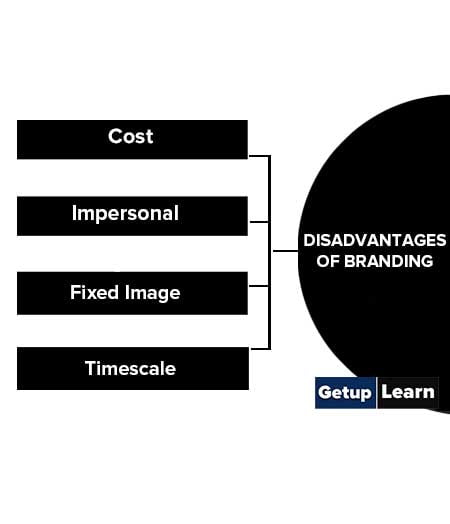
Cost
If you wish to create and maintain a strong brand presence, it can involve a lot of design and marketing costs. A strong brand is memorable, but people still need to be exposed to it, this often requires a lot of advertising and PR over a long period of time, which can be very costly.
There are also costs involved with the creating of a brand image or logo (Paying for a designer, printing new letterheads/business cards etc.), and although most of these are only one off costs, they are still relatively large for most small businesses.
The exposure of your brand can be left to word of mouth, this will save you money, but will also greatly slow down the exposure your brand receives.
Impersonal
One of the main problems with many branded businesses is that they lose their personal image. The ability to deal on a personal basis with customers is one of the biggest advantages small business have, and poorly designed branding could give customers the impression that your business is losing its personal touch.
Fixed Image
Every brand has a certain image to potential customers, and part of that image is about what products or services you sell. If you are known for selling just one product, and you want to sell another product, will you be able to do so effectively?
If you sell computers, would your brand name be suitable for selling vacuum cleaners? If your brand is focused too strongly on one product, it can limit your ability to sell other products.
Timescale
The process of creating a brand will usually take a long period of time. As well as creating a brand and updating your signs and equipment (For example, Stationary, vehicles etc…), you need to expose it to your potential customers.
It is commonly shown that people need to see an advert at least three times before they absorb it, which means you will need to advertise and promote the brand for a considerable amount of time before it will become well known.
What are the types of brands?
Types of brands are:
1. Individual Brands
2. Family Brands
3. Manufacturing Brands
4. Dealer Brands
5. Generic Brand
6. Licensed Brand.
What are the advantages of branding?
These are the advantages of branding:
1. To Consumers
2. To Owners
3. To Intermediaries.
What are the disadvantages of branding?
These are the disadvantages of branding:
14.1 Cost
14.2 Impersonal
14.3 Fixed Image
14.4 Timescale.


